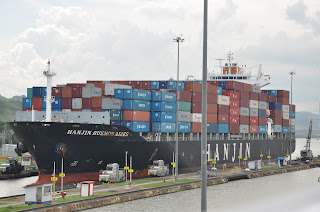Tuesday, August 20
We left our hotel early this morning at 6:00 am because we had a long and windy drive through the mountains to Bocas Del Toro. Before we left David we picked up one of Luis’ friends to drive us since he did not have his license and we did not want to run into anymore problems with checkpoints. Bocas Del Toro is on the far East side of the country and borders Costa Rica so there is more border security in the area. Since we knew the drive through the mountains and extremely windy Jessica took another Dramamine and was out. The drive was beautiful as we went up an over the mountains. There were many indigenous indians living in the area and there houses resembled nothing more than tree houses children construct and play in in the U.S. Seeing this first hand makes you realize how fortunate we are and to not take for granted what you have at home.
 |
| A quick shot of a home of an indigenous indian |
 |
| Vegetable industry in Bocas |
The drive took about 3 hours but we finally arrived in the small town of Changuinola, Bocas Del Toro. We met Fernando, a ranch manager for an absentee owner, at a McDonalds before he took us to the ranch we would visit for the day. The ranch was both a cow calf operation as well as a finisher and used cross breeding of Brahman, Simental, and Senepol. We drove through the ranch and saw the operation where they finished the steer calves as well as bought additional cattle to finish on grass and were not supplemented at all. After looking at the growing division, we drove to another part of the ranch and saw the cow herd. The calves that we saw had great genetics and even saw some Brahman/Senepol crosses. These were probably the best calves we have seen so far and you see why people think this may be the breed of the future for the country. The calves were extremely stout and had great muscling, Fernando also explained they were great mothers and produced great milk.
 |
| Steers (actually bulls-they do not castrate anything) Fernando was growing out |
 |
| A couple Senepol cross calves-pretty fancy |
 |
| Gunna definitely be a cow one day |
After looking at the ranch, Fernando took us on a quick tour of the area. The agriculture area was spectacular and there were banana plantations everywhere which were all Chiquita Banana farms. As we continued to drive, we went through a very impoverished area where there were many indigenous indians who lived in this area. We really had a glimpse of what life was like in the 3rd world areas of Latin America and it was difficult to look at some of the conditions the people were living under. Fernando told us to pull over in a remote area and we walked through a dense forest where we came out on the Sixaola River, the border between Panama and Costa Rica. We took a few pictures and then he took us to the actual border crossing where there was tons of people going back and forth across a bridge between Panama and Costa Rica. He asked us if we wanted to go to Costa Rica, and after a little convincing of Jess, we decided to make the trip. You only live once and how many other times where we going to be presented an opportunity to experience and opportunity like this right? We walked up to the bridge where none of the border police asked to see our passports (didn’t even get a stamp for proof) and walked across the bridge to Costa Rica. We bought a couple bottles of water from a local Costa Rican market (have to support the local economy) and returned to Panama.
 |
| Chiquita Banana Plantaion |
 |
| A local bus in Boca (no joke)-"Nothing Runs Like A Deer" |
 |
| The house of an indigenous indian |
 |
| This little fella got him a pig on a leash |
 |
| Sixaola River-The other side is Costa Rica |
 |
| Wild Bananas |
 |
| Headed To Costa Rica |
 |
| Sixaola River-The border between Panama and Costa Rica |
 |
| We Made it |
 |
| A local vegetable stand in Costa Rica |
 |
| This guy said the Banana market was better in Panama and was headed to capitalizing on international marking |
 |
| Headed back across |
 |
| Indians doing Laundry in the Sixoala River |
 |
| Home sweet home |


















































